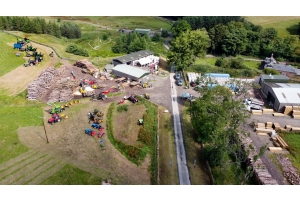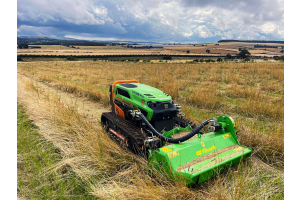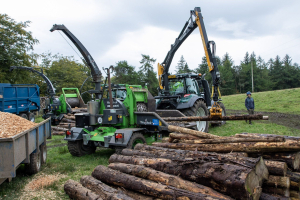This is a demo store. No orders will be fulfilled.
A Look Around the Malwa Factory

Following my last post on how we ended up in Sweden at the Malwa factory (see post here), this is a more in-depth look at the machines and how they are made.
Following Malwa's success with their 460 forwarder they wanted to build a harvester which would match it. However they also decided that to maximise on their development and manufacturing investments they should update the forwarder at the same time and keep as many components as possible the same so that both machines would benefit. This led to their 560 range which includes a harvester, forwarder and a combi machine, which can be switched between harvester and forwarder.
All machines in the 560 range share the same cab, engine and hydraulic components, some elements of the chassis, and the control system. This has led to the forwarder being over specified in terms of power and oilflow, meaning it can be run at low engine speeds, reducing noise, engine load and therefore improving efficiency.
One of the main elements that Malwa decided to concentrate on was operator comfort. Their aim was to build a professional level machine which could be used all day everyday, as opposed to some of the other small scale machinery which is designed more for occasional or part time use. The cabin is well insulated and damped, reducing noise levels, fitted with air conditioning and radio as standard, and with all controls within easy reach, most of them located on or around the armrest mounted mini levers.
In order to achieve the level of quality and reliability required for full time forestry use they have used high quality components from well known manufacturers. The machines are powered by Caterpillar engines running Bosch Rexroth pumps, fitted with Cranab or Moheda cranes and controlled by an IQAN control system.
The frame and chassis components are made from quality steel in a highly technical steel fabrication workshop located next door to the assembly plant. All components are laser cut and welded before being powder coated to ensure a good finish with long lasting protection prior to assembly. Everything is then brought together and assembled by hand to give the final products.
The machines are well thought out with excellent access to all components to allow for ease of maintenance and servicing. The use of well known components also means that sourcing spares and consumables should be easy and finding a local mechanic or engineer who is familiar with the components shouldn't be a problem. A complete stock of spare parts are also kept ready for immediate dispatch from the Malwa factory.
All in all we were very impressed with the manufacturing facility and all the people behind the machines, who make them what they are. The company is constantly increasing production and is due to move to larger premises next door later this year.
Below are a selection of pictures of the manufacturing process.
Please give us a call if you want to know anything more about Malwa or their machines and make sure to come and see us at the APF later this month.
Malwa centre pivot section awaiting powdercoating. All frame components are carefully designed, laser cut and welded from high quality steel
The centre pivot fully painted and assembled with large bearings and drive shaft passing through the centre
Rear bogie with chain drive and hub reductions for the direct drive
Front frame with hydraulic motor and gearbox fitted, awaiting the cab and engine
Cabs are assembled and fitted out seperately before being fitted to the chassis
Cat engine with Bosch Rexroth pumps awaiting fitting
Engine in place with good access to filters for servicing.
Front and rear frames joined and crane being fitted. Moheda cranes are popular in Sweden but now most of their machines are fitted with Cranab cranes
Part assembled forwarder awaiting engine, cab and bunk, with a nearly complete machine in the background
The finished product: a Malwa 560F forwarder being tested by Gavin Marshall















